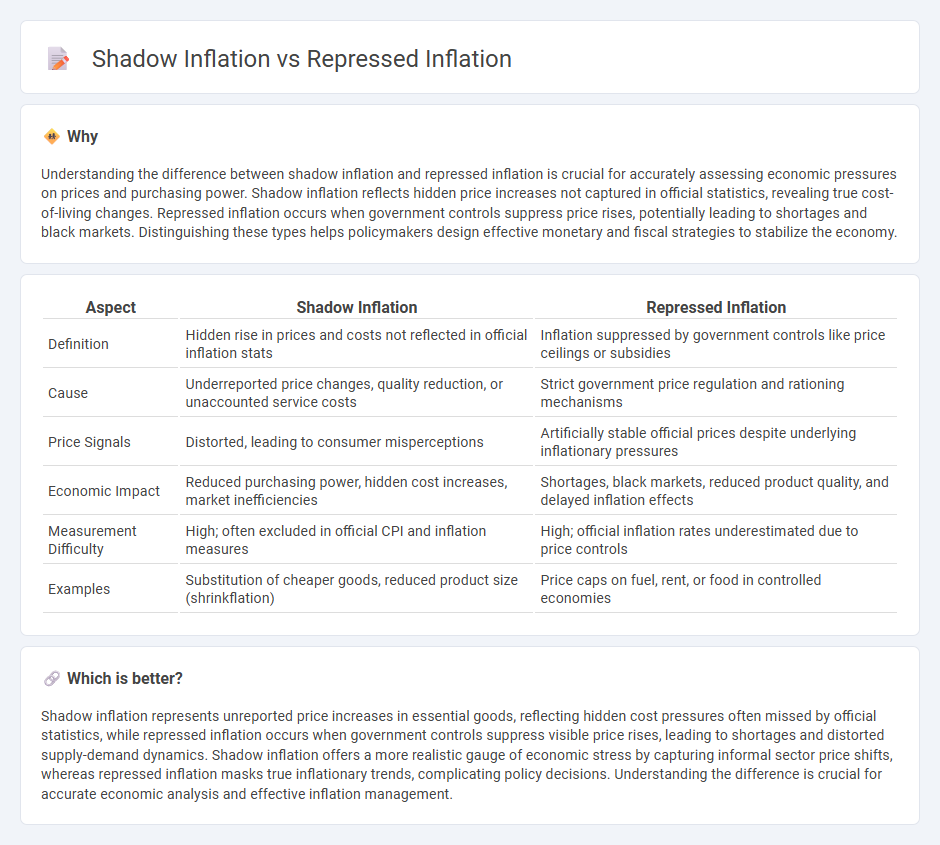
Shadow inflation refers to the hidden rise in prices of quality reductions or product size shrinkages that do not appear in official inflation statistics, masking the true cost increases faced by consumers. Repressed inflation occurs when government controls or price regulations artificially suppress price rises, leading to shortages and black markets. Explore how these inflation types impact economic stability and consumer purchasing power.
Why it is important
Understanding the difference between shadow inflation and repressed inflation is crucial for accurately assessing economic pressures on prices and purchasing power. Shadow inflation reflects hidden price increases not captured in official statistics, revealing true cost-of-living changes. Repressed inflation occurs when government controls suppress price rises, potentially leading to shortages and black markets. Distinguishing these types helps policymakers design effective monetary and fiscal strategies to stabilize the economy.
Comparison Table
| Aspect | Shadow Inflation | Repressed Inflation |
|---|---|---|
| Definition | Hidden rise in prices and costs not reflected in official inflation stats | Inflation suppressed by government controls like price ceilings or subsidies |
| Cause | Underreported price changes, quality reduction, or unaccounted service costs | Strict government price regulation and rationing mechanisms |
| Price Signals | Distorted, leading to consumer misperceptions | Artificially stable official prices despite underlying inflationary pressures |
| Economic Impact | Reduced purchasing power, hidden cost increases, market inefficiencies | Shortages, black markets, reduced product quality, and delayed inflation effects |
| Measurement Difficulty | High; often excluded in official CPI and inflation measures | High; official inflation rates underestimated due to price controls |
| Examples | Substitution of cheaper goods, reduced product size (shrinkflation) | Price caps on fuel, rent, or food in controlled economies |
Which is better?
Shadow inflation represents unreported price increases in essential goods, reflecting hidden cost pressures often missed by official statistics, while repressed inflation occurs when government controls suppress visible price rises, leading to shortages and distorted supply-demand dynamics. Shadow inflation offers a more realistic gauge of economic stress by capturing informal sector price shifts, whereas repressed inflation masks true inflationary trends, complicating policy decisions. Understanding the difference is crucial for accurate economic analysis and effective inflation management.
Connection
Shadow inflation and repressed inflation are interconnected as both represent the hidden pressures on an economy caused by rising costs and suppressed price signals. Shadow inflation occurs when unofficial or unmeasured price increases impact the cost of living, while repressed inflation arises when governments cap prices, leading to shortages and black markets. These phenomena distort economic data and policy responses, complicating efforts to control actual inflation rates.
Key Terms
Price Controls
Repressed inflation occurs when government-imposed price controls keep official prices artificially low despite rising demand, leading to shortages and black markets as consumers compete for limited goods. Shadow inflation reflects the true increase in consumer prices in the unofficial economy, where goods and services are sold above controlled prices, revealing the hidden cost pressures not captured by official inflation measures. Explore deeper insights into how price controls shape economic distortions and affect inflation dynamics.
Hidden Costs
Repressed inflation occurs when price increases are artificially suppressed by government controls, forcing consumers to pay hidden costs such as reduced product quality and scarcity. Shadow inflation reflects the covert rise in living expenses through indirect price hikes, like downsizing product sizes or cutting service quality without official price increases. Explore more to understand how hidden costs impact economic stability and consumer budgets.
Quality Reduction
Repressed inflation occurs when official prices remain stable despite rising production costs, often leading producers to reduce product quality as a hidden form of inflation. Shadow inflation, on the other hand, captures these indirect price increases reflected through quality downgrades, making it a critical measure for understanding true inflationary pressures. Explore more to gain insight into how quality reduction impacts real inflation rates and consumer purchasing power.
Source and External Links
Repressed Inflation Definition & Examples - Quickonomics - Repressed inflation occurs when governments use price controls, rationing, or subsidies to artificially suppress price increases, often leading to shortages and black markets as underlying inflationary pressures are masked rather than resolved.
Repressed Inflation - IMF eLibrary - In repressed inflation, aggregate demand exceeds supply but price controls prevent official prices from rising, resulting in forced savings, wealth overhang, and consumption below desired levels if parallel markets are inaccessible.
REPRESSED INFLATION - Wiley Online Library - Repressed inflation exacerbates economic issues by combining stagnation with unbalanced production and inequitable distribution, worsening the overall economic situation compared to open inflation.
 dowidth.com
dowidth.com